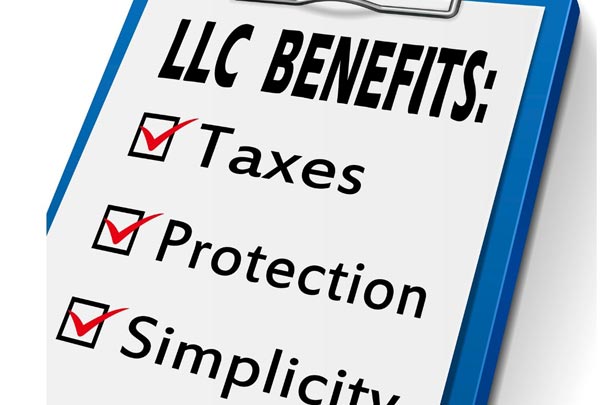The Basics of Limited Liability Companies (LLCs)
A limited liability company (LLC) is an ownership organization similar to a corporation. It combines attributes of both corporations and partnerships (or, for one-person LLCs, sole proprietorships). An LLC offers the corporation’s protection from personal liability for business debts and the pass-through tax structure of partnerships and sole proprietorships. Although more work is required to set up an LLC than a partnership or sole proprietorship, running an LLC is much easier than running a corporation. If you have concerns about being held personally liable for debts of your business, then it would probably be a good idea to have an LLC.
Here are the main features of an LLC:
Limited Personal Liability
Like shareholders of a corporation, all LLC owners are protected from personal liability for business debts and claims. This means that if the business itself can’t pay a creditor, such as a supplier, a lender, or a landlord, the creditor cannot legally come after the house, car, or other personal possessions owned by any of the LLC members. Since only LLC assets are used to pay off business debts, LLC owners stand to lose only the money they’ve invested in the LLC. This feature is also known as “limited liability.”
The exceptions to Limited Liability
While LLC owners enjoy limited personal liability for most of their business transactions, it is important to realize that this protection is not absolute. This drawback is not unique to LLCs because the same exceptions also apply to corporations. An LLC owner can be held personally liable if he:
- personally and directly injures someone
- personally guarantees a bank loan or a business debt on which the LLC defaults
- fails to deposit taxes that are withheld from employees’ wages
- intentionally does something fraudulent, illegal, or clearly wrong-headed thereby causing harm to the company or to someone else, or
- treats the LLC as an extension of his personal affairs, rather than as a separate legal entity.
The last exception is the most important of all. In some cases, a court might say that the LLC doesn’t really exist and finds that its owners are really doing business as individuals who are personally liable for their acts. To prevent this, make sure you and your co-owners:
Act fairly and legally. Never conceal or misrepresent material facts or the state of your finances to vendors, creditors, or other outsiders.
Fund your LLC adequately. Invest enough cash into the business so that your LLC can meet predictable expenses and liabilities.
Keep LLC and personal business separate. Get a federal employer identification number, open up a business-only checking account, and keep your personal finances out of your LLC accounting books.
Create an operating agreement. Having a formal written operating agreement lends credibility to your LLC’s separate existence.
Business Insurance
A good liability insurance policy shields your personal assets when limited liability protection does not. For example, if you are a masseuse and you accidentally injure a client’s back, you should be covered by your liability insurance policy. Insurance can also protect your personal assets if your limited liability status is ignored by a court.
In addition to protecting your personal assets in these situations, insurance can also protect your corporate assets from lawsuits and claims. However, you should be aware that commercial insurance in most cases does not protect personal or corporate assets from unpaid business debts, whether or not they’re personally guaranteed.

Limited Liability Company
-
LLC shareholder or member
-
Why do we need LLC’s?
-
The businesses that benefit from LLCs
-
The basics of Limited Liability Companies (LLCs)
- Articles of Organization for Limited Liability Companies
- The advantages of Limited Liability Companies (LLCs)
- The differences between Limited Liability Companies/Limited Partnerships and Corporations
- LLC’s Part One – History
- LLC’s Part Two – Formation, Structure and Operating Agreement
- LLC’s Part Three – Membership Interests and Member Contributions
- LLC’s Part Four – Liability
- LLC’s Part Five – Records, Books and Taxation
- LLC’s Part Six – Centralized Management and Transferability of Interests
- LLC’s Part Seven – Continuity of Life, Withdrawal of Members and Dissolution
- Delaware Series Limited Liability Company
- Kentucky closes loopholes in limited liability companies
- Frequently asked questions about Limited Liability Companies (LLCs) – Part One
- Frequently asked questions about Limited Liability Companies (LLCs) – Part Two
- Frequently asked questions about Limited Liability Companies (LLCs) – Part Three
- Advantages of a Limited Liability Company
- Advantages of a Limited Liability Company (LLC) over a Limited Partnership
- Advantages of a Limited Liability Company (LLC) over an S Corporation
- Facts about Limited Liability Companies (LLCs)
- More frequently asked questions about Limited Liability Companies – Part One
- More frequently asked questions about Limited Liability Companies – Part Two
- More frequently asked questions about Limited Liability Companies – Part Three
- More frequently asked questions about Limited Liability Companies – Part Four
- More frequently asked questions about Limited Liability Companies – Part Five
newsletter signup
[forminator_form id=”1485″]

FIGHTING BACK!
